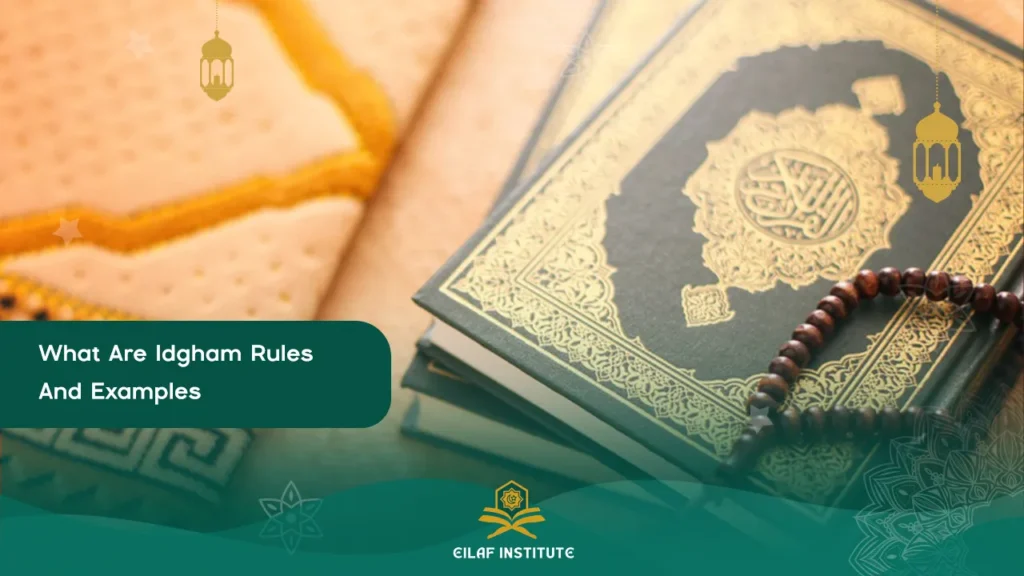In this comprehensive guide, we dive deep into the concept of Idgham, one of the foundational rules of Tajweed. If you’ve ever wondered “What Are Idgham Rules And Examples?” you’re in the right place.
We’ll explore the true essence of Idgham, highlight the specific letters it involves, and clarify the purpose behind this important rule in Quranic recitation. Whether you’re just beginning your Tajweed journey or looking to enhance your fluency and precision, this guide will support you every step of the way.
What is Idgham?
Discovering the Harmony: Idgham, in the context of Tajweed, refers to the assimilation or merging of certain letters in specific conditions during Quranic recitation. It’s a fascinating aspect of the art of beautiful Quranic recitation that adds a layer of fluidity and grace to your reading.
What are Idgham Letters?
Idgham involves the harmonious merging of specific letters with a nasal sound, creating a seamless transition between sounds.
The Idgham happens if Noon As-Sakinah(ن) or At-tanween (ـٌـًـٍ) are followed by one of Idgham letters grouped in this word (يرملون), and these letters are divided into 2 types of idgram.
We’ll dive into the nuances of these letters and witness how their fusion enhances the cadence of your recitation.
What is the Purpose of Idgham?
The purpose of Idgham extends beyond a mere Tajweed rule; it aims to enhance the auditory beauty of Quranic recitation. By understanding idgham rules and examples, you will add a melodic flow while reciting the Quran, which allows you to navigate the verses with rhythm and eloquence. Understand the profound purpose behind this Tajweed rule and elevate your recitation to a new level of mastery.
Read also about : learn quran recitation with tajweed
What are idgham rules and examples?
Idgham, in the context of Tajweed (the rules of Quranic recitation), refers to the assimilation or merging of certain letters under specific conditions. The primary focus of idgham rules and examples is on the smooth transition between two adjacent sounds. There are different rules of Idgham, and they are as follows:
Idgham with Ghunnah (Nasal Sound):
The first rule of idgham rules and examples Idgham occurs when a Noon Sakinah (نْ) or Tanween (ـٌـًـٍ) is followed by one of the letters of Idgham (ينمو).
Examples of Idgham with Ghunnah
“وَٱلنَّهَارِ إِذَا جَلَّٰهَا” (Surah Al-Furqan, 25:9) – Pronounce “وَٱلنَّهَارِ” (walnnahāri) with the assimilation of the “n” in “nna” into the following “m” in “nahāri.”
Idgham without Ghunnah (Nasal Sound):
The second rule of idgham rules and examples is that Idgham without a nasal sound occurs when a Mim Sakinah (مْ) is followed by one of the letters of Idgham (Meem or Noon).
Examples of Idgham without Ghunnah:
“فَإِنِ انْتَهَوْا فَإِنَّ اللَّـهَ غَفُورٌ رَحِيمٌ (Al-Baqarah, verse 192)” – Pronounce “غَفُورٌ” with the assimilation of the “raa” in “غَفُورٌ” into the following “Raa” in “رَحِيمٌ.”
Read also about: how to pray taraweeh-during ramadan.
Idgham in Terms of Kamil and Naqis
After exploring What Are Idgham Rules And Examples, you need to know Idgham in Terms of Kamil and Naqis.
Al Idgham Al Kamil
It is where the first letter in Al Idgham Al Kamil completely loses its pronunciation and characteristics. This means it fully melts in the next letter.
Al Ingham An Naqis
In Al Idgham An Naqis, some of the features of the first letter remain, although it still merges with the letter that follows; thus, a partial retention of its qualities in pronunciation.
When To Pronounce the Idgham in Tajweed?
In the captivating world of Tajweed, understanding Idgham rules and examples is key to unlocking the melodic beauty of Quranic recitation. At Eilaf Institute, we guide you through the nuances of this unique Tajweed rule, ensuring that your recitation resonates with precision and eloquence. Here are idgham letters examples:
Noon Sakinah or Tanween followed by a Meem (ن ر):
When you encounter a Noon Sakinah (نْ) or Tanween (ـٌــًـٍ) followed by a Raa (ر), embrace the art of Idgham. Merge the nasal sound of the noon or tanween seamlessly with the Raa, creating a fluid transition that enhances the musicality of your recitation.
Example: “ أُولَـٰئِكَ عَلَىٰ هُدًى مِنْ رَبِّهِمْ ۖ وَأُولَـٰئِكَ هُمُ الْمُفْلِحُونَ (Al-Baqarah:5)” This is an example of Idghaam without Ghunnah in the Quran:
Noon Sakinah or Tanween followed by a Noon (ن ن):
In certain cases, when a Noon Sakinah or Tanween is followed by a Noon, the rules of Idgham apply. Effortlessly connect the nasal sound of the first noon or tanween with the subsequent noon.
Example: Pronounce “وَمِن نِّسَآئِهِ” (wa-min nisā’ihi) with the assimilation of the “n” in “min” into the following “n” in “nisā’ihi.”
Exception: Noon Sakinah or Tanween followed by yaa (ي):
In instances where a Noon Sakinah or Tanween is followed by (ي) apply Idgham by merging the nasal sound of the noon or tanween with the doubled meem.
Example: “وَمِنَ النَّاسِ مَنْ يَقُولُ آمَنَّا بِاللَّـهِ وَبِالْيَوْمِ الْآخِرِ وَمَا هُمْ بِمُؤْمِنِينَ (Al-Baqarah:8).” this is an example of Idgham with Ghunnah.
The above is a simplified explanation of What Are Idgham Rules And Examples.
Read also about: A 7 steps to learn quran with tajweed at home
Eilaf Institute: Your Gateway to Tajweed Mastery
At Eilaf Institute, we are dedicated to empowering your journey in mastering the art of Tajweed. Whether you’re a novice or an advanced learner, understanding Idgham is a pivotal step in perfecting your recitation.
Join us as we unravel the intricacies of Tajweed, making every recitation a harmonious and spiritually enriching experience.
Book now online Quran reading

